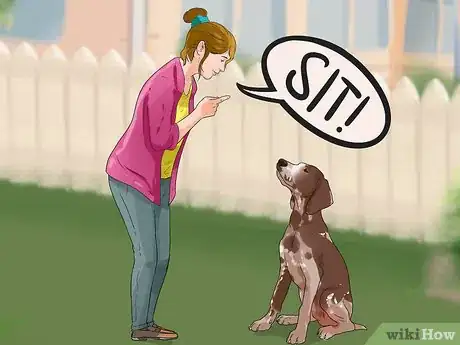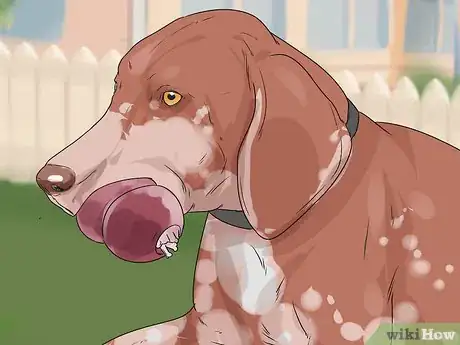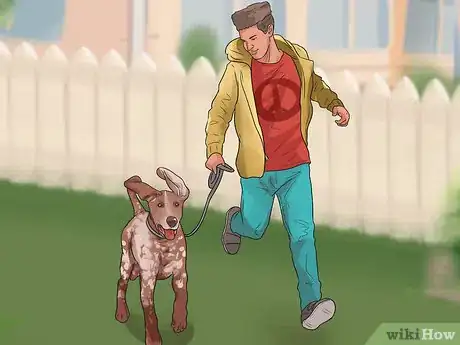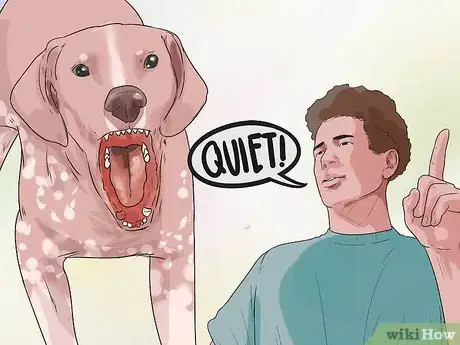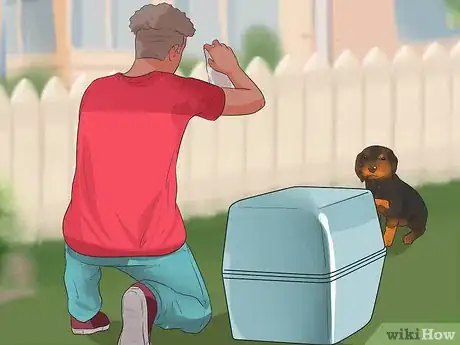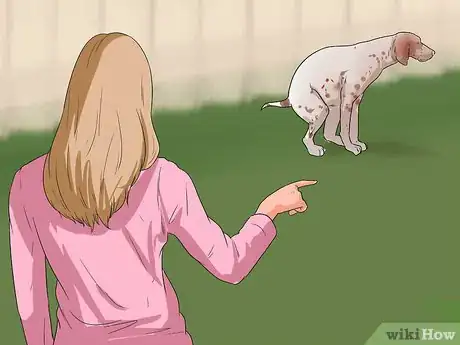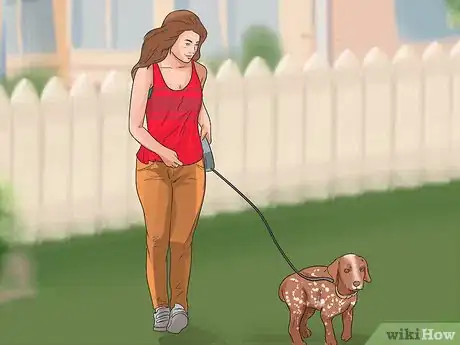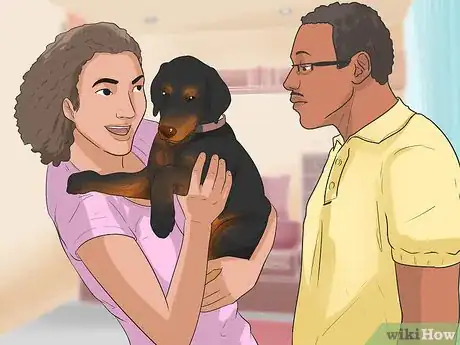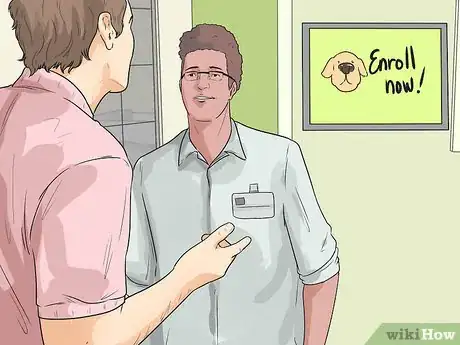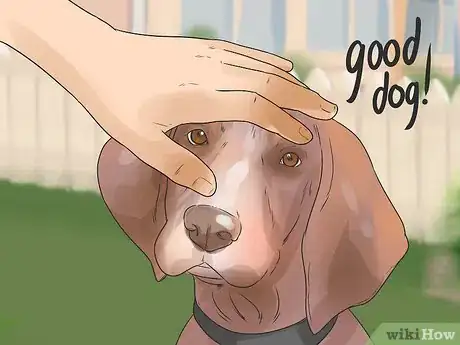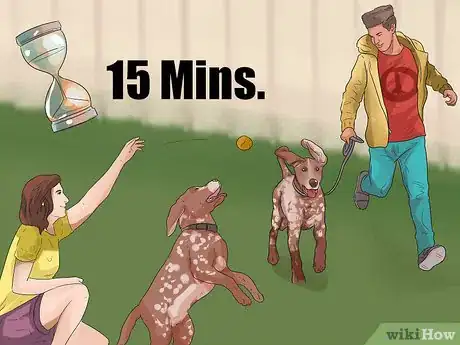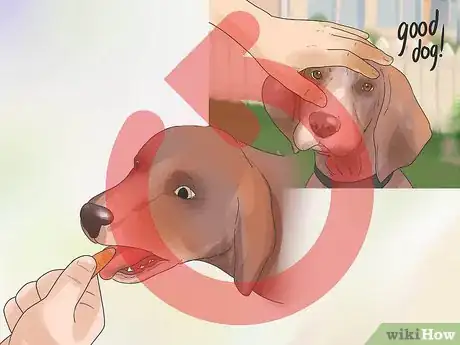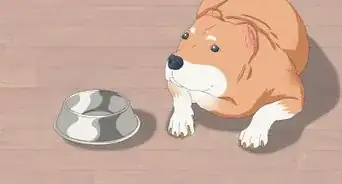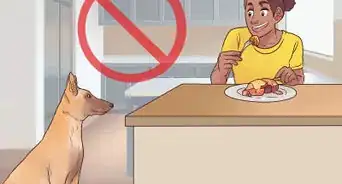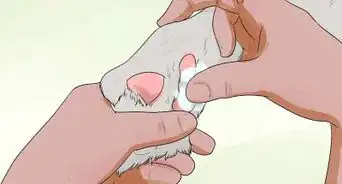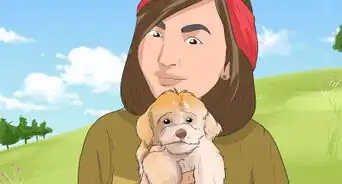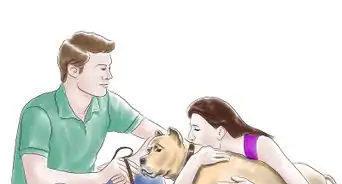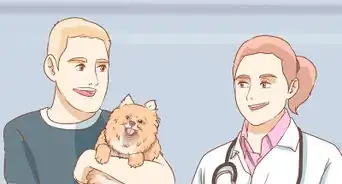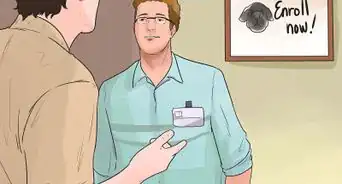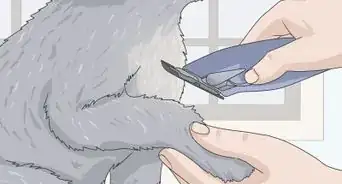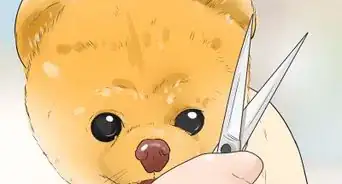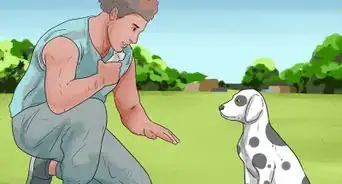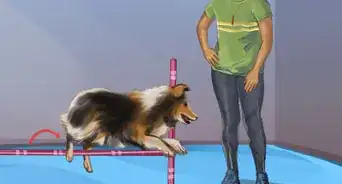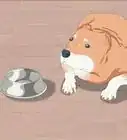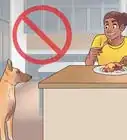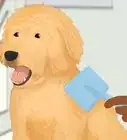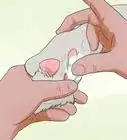This article was co-authored by Pippa Elliott, MRCVS. Dr. Elliott, BVMS, MRCVS is a veterinarian with over 30 years of experience in veterinary surgery and companion animal practice. She graduated from the University of Glasgow in 1987 with a degree in veterinary medicine and surgery. She has worked at the same animal clinic in her hometown for over 20 years.
There are 16 references cited in this article, which can be found at the bottom of the page.
wikiHow marks an article as reader-approved once it receives enough positive feedback. In this case, 89% of readers who voted found the article helpful, earning it our reader-approved status.
This article has been viewed 100,030 times.
German shorthaired pointers (GSP) are athletic, lovable dogs that are eager to please and easy to train. They are also very intelligent and creative.[1] Training your GSP can be a fun and rewarding experience for the both of you. With time, patience, and plenty of treats, you will be able to train your GSP so it becomes a well-behaved member of your family.
Steps
Behavioral Management
-
1Train your GSP to follow basic commands. Basic commands will help your GSP behave properly. There a few commands every dog should know: sit, stay, come, and heel. Mastering these basic commands will give your GSP a foundation for learning more advanced skills.
- Since GSPs are so intelligent, it probably won’t take long for your GSP to learn these basic commands.
-
2Manage your GSP’s hunting instinct. GSPs were bred to hunt.[2] If you do not intend to use your GSP to hunt wildlife, though, you will need to manage this hunting instinct. Otherwise, your GSP will bring you ‘trophies’ of dead animals, such as dead rats or rabbits.
- To redirect your GSP’s hunting instinct, give him toys to play with that will keep him busy for long stretches of time. For example, give him a Kong toy, which is a food puzzle.[3]
- You can also play fetch and tug of war with your GSP. You could even have it chase you (in a playful way, of course).[4]
- Your goal should not be to eliminate your GSP’s instinct to hunt. Rather, you should channel that instinct into something more appropriate for your living environment.
Advertisement -
3Exercise with your GSP each day. Your GSP will need a lot of exercise each day. Without enough exercise, your GSP will come up with ‘creative’ ways to release its pent-up energy, which may result in some type of destruction (e.g., holes being dug throughout the backyard). Examples of exercises for your GSP are swimming, running, and playing fetch with a Frisbee. Plan to exercise with your dog each morning and evening.[5]
- Hiking is another way to exercise your GSP.[6]
- Long walks can also provide a good energy outlet for your GSP.
-
4Control your GSP’s barking. GSPs have a tendency to bark a lot. If your GSP’s barking has become a problem, you will need to control when it barks and stays quiet. First, you will train your GSP to bark on command by saying ‘speak.’ Then, you will teach your GSP the ‘quiet’ command. With these 2 commands, your GSP will know when to bark and when not to.
Well-Rounded Training
-
1Crate train your puppy. Crate training is an important aspect of training your GSP puppy. As with all puppies, GSP puppies need constant supervision. If you cannot watch your GSP puppy all day, then crate training will help keep it out of trouble when you're not around. After introducing your puppy to the crate and encouraging it to spend more time in the crate, your puppy will eventually see the crate as a place of safety and comfort.[7]
- During the crate training process, make the crate comfortable for your puppy by putting toys and a blanket in the crate and placing a blanket or sheet on top of the crate.[8]
- The blanket or sheet on top of the crate will make it feel like a cozy den to your puppy.
- Crate training has several benefits. It will keep your puppy out of trouble while you are away from home and will make housetraining a little easier. As your puppy matures into an adult, the crate can become a defined sleeping area.[9]
- Pick a crate size that is large enough for an adult GSP. A 36 x 36 inch (91 x 91 cm) crate would be a good size. Some crates have an adjustable interior so you can increase the amount of space in the crate as a puppy grows.
- Do not rush the crate training process. It may take your puppy a few weeks, or even a few months, before it’s comfortable staying in the crate for long time periods.
-
2House train your puppy. Crate training and house training go hand in hand—your GSP puppy will not want to eliminate where it sleeps (in the crate), so your puppy will learn to eliminate only outside. Create a bathroom schedule for your puppy and follow it consistently. Your puppy should eliminate outside after waking up, before bedtime, and after eating, drinking, or playing.[10]
- Let your puppy choose an area outside to eliminate and always take it to that area. Your puppy will leave its scent in the area.[11]
- Give your puppy lots of verbal praise when it eliminates outside. This will reinforce to your puppy that going to the bathroom outside is the right thing to do.
- If your puppy has an indoor bathroom accident, clean it up without punishing him. Use an enzymatic cleaner to remove the scent of ammonia so your puppy doesn’t eliminate in that spot again.[12]
- GSP puppies can hold their bladders for about 1 hour per month of age. Consider hiring a pet sitter or dog walker who could take your puppy out twice during the day when you’re not home.
-
3Leash train your puppy. GSPs are fully of energy, especially as puppies. All of that energy could make leash walking a daily challenge. Teaching your GSP to walk on a leash will make walks more enjoyable for both of you. First, allow your puppy to become used to wearing a collar. Your puppy may try to take it off at first, but will eventually become used to it. You can then attach a leash to the collar and let your puppy walk around the house with the leash on.[13]
- If your puppy starts to pull when you go on walks outside, do not jerk the leash. Instead, stop walking and call your puppy back to you. You can also start walking in the other direction. Your puppy will soon realize that it should follow you.
- Giving your puppy periodic treats during the walk will help reinforce good leash behavior. Reward your puppy when it does not pull on the leash.
-
4Socialize your puppy. Socialization is a critical aspect of dog training. It allows a dog to become comfortable with people, other pets, and new experiences. Since GSPs can be wary of other dogs, early socialization will help your GSP puppy become comfortable meeting and interacting with new dogs.[14] Socialization should take place between 3 weeks and 3 months of age.[15]
- Strategies for socializing your puppy include regular introductions to friendly people and going to busy parks.[16]
- The more people (and pets) your puppy can meet during the socialization period, the more well-adjusted it will be as an adult.
- Wait until your puppy is fully vaccinated before going to a dog park. Otherwise, your puppy could get exposed to a disease at a dog park that could make it very sick. Your vet can recommend a good age for him to go to a dog park. Feel free to take him to ‘people’ parks.
- Dogs that are not properly socialized will be fearful of new situations and act inappropriately around people and other pets.
-
5Enroll your puppy in puppy kindergarten. Puppy kindergarten class is a great way to socialize your puppy. Your GSP puppy will learn how to interact with other dogs in a playful, yet controlled environment. In puppy kindergarten, your puppy will also start learning some basic commands.[17] Ask your veterinarian or other dog owners about puppy kindergarten classes in your area.
General Training Tips
-
1Use positive reinforcement. Positive reinforcement encourages a dog to continue doing the right thing. Examples of positive reinforcement are verbal praise, treats, and extra petting. Your GSP will work hard for your positive reinforcement.[18] The more positive reinforcement your GSP receives, the more likely it will follow commands correctly and behave well.
- Positive reinforcement can also add energy and enthusiasm to your training sessions.
- Do not use negative reinforcement, such as yelling or physical punishment. GSPs are very sensitive to human reactions, so yelling or physical punishment will negatively affect your GSP.[19]
-
2Keep training sessions short. GSPs are very intelligent and quickly learn new tasks, but get bored very easily. Keeping your training sessions short—no longer than 15 minutes—will help prevent this boredom. End each training session on a high note and give your GSP positive reinforcement for a job well done.[20]
- GSPs also get easily distracted. Smelling something different in the air could be enough to distract your GSP from the task at hand. Short training sessions could help your dog stay focused for short bursts of time.
-
3Be consistent and repetitive. When you teach your GSP new tricks or commands, consistency and repetition are key to ensuring mastery of a certain task.[21] Since your GSP is prone to distraction, hearing a command multiple times may be necessary to maintain focus.
- To counteract the distraction, offer your GSP plenty of treats. The smell of a tasty treat in your hand will help your GSP refocus its attention on you.
Expert Q&A
Did you know you can get expert answers for this article?
Unlock expert answers by supporting wikiHow
-
QuestionHow much do German shorthaired pointers shed?
 Pippa Elliott, MRCVSDr. Elliott, BVMS, MRCVS is a veterinarian with over 30 years of experience in veterinary surgery and companion animal practice. She graduated from the University of Glasgow in 1987 with a degree in veterinary medicine and surgery. She has worked at the same animal clinic in her hometown for over 20 years.
Pippa Elliott, MRCVSDr. Elliott, BVMS, MRCVS is a veterinarian with over 30 years of experience in veterinary surgery and companion animal practice. She graduated from the University of Glasgow in 1987 with a degree in veterinary medicine and surgery. She has worked at the same animal clinic in her hometown for over 20 years.
Veterinarian
-
QuestionHow do you potty train a pointer?
 Pippa Elliott, MRCVSDr. Elliott, BVMS, MRCVS is a veterinarian with over 30 years of experience in veterinary surgery and companion animal practice. She graduated from the University of Glasgow in 1987 with a degree in veterinary medicine and surgery. She has worked at the same animal clinic in her hometown for over 20 years.
Pippa Elliott, MRCVSDr. Elliott, BVMS, MRCVS is a veterinarian with over 30 years of experience in veterinary surgery and companion animal practice. She graduated from the University of Glasgow in 1987 with a degree in veterinary medicine and surgery. She has worked at the same animal clinic in her hometown for over 20 years.
Veterinarian
-
QuestionAre German shorthaired pointers easy to train?
 Pippa Elliott, MRCVSDr. Elliott, BVMS, MRCVS is a veterinarian with over 30 years of experience in veterinary surgery and companion animal practice. She graduated from the University of Glasgow in 1987 with a degree in veterinary medicine and surgery. She has worked at the same animal clinic in her hometown for over 20 years.
Pippa Elliott, MRCVSDr. Elliott, BVMS, MRCVS is a veterinarian with over 30 years of experience in veterinary surgery and companion animal practice. She graduated from the University of Glasgow in 1987 with a degree in veterinary medicine and surgery. She has worked at the same animal clinic in her hometown for over 20 years.
Veterinarian
Warnings
- Harsh training and negative reinforcement can make a GSP very stubborn.[23]⧼thumbs_response⧽
References
- ↑ http://www.gspca.org/Breed/FAQ.html
- ↑ http://www.gspca.org/Breed/FAQ.html
- ↑ http://www.canismajor.com/dog/hidrive.html
- ↑ http://www.labradortraininghq.com/labrador-behavior/dog-instincts-and-drives/#Prey_Drive
- ↑ http://www.gspca.org/Breed/FAQ.html
- ↑ https://www.vetary.com/dog/breeds/german-shorthaired-pointer
- ↑ http://www.humanesociety.org/animals/dogs/tips/crate_training.html
- ↑ http://www.brown.edu/Research/Colwill_Lab/CBP/Crate.htm
- ↑ http://www.gspca.org/Breed/FAQ.html
- ↑ http://www.akc.org/learn/akc-training/how-to-potty-train-a-puppy/
- ↑ http://www.bostonterrierforums.com/training/house-training-your-boston-terrier
- ↑ http://members.rennlist.org/warren/havanese.pdf
- ↑ https://www.cuteness.com/article/train-german-shorthaired-pointer-puppies
- ↑ http://dogtime.com/dog-breeds/german-shorthaired-pointer
- ↑ https://drsophiayin.com/blog/entry/puppy-socialization-stop-fear-before-it-starts/
- ↑ http://www.labradortraininghq.com/labrador-behavior/dog-instincts-and-drives/#Prey_Drive
- ↑ https://www.petcarerx.com/article/collie-training-tips/421
- ↑ http://www.gspca.org/Breed/standard.html
- ↑ http://www.animalplanet.com/breed-selector/dog-breeds/sporting/german-shorthaired-pointer.html
- ↑ http://dogtime.com/dog-breeds/german-shorthaired-pointer
- ↑ http://www.akc.org/dog-breeds/german-shorthaired-pointer/detail/
- ↑ http://www.gspca.org/Breed/FAQ.html
- ↑ http://dogtime.com/dog-breeds/german-shorthaired-pointer
About This Article
To train a German shorthaired pointer, always use positive reinforcement, like treats, praise, and petting, whenever your dog does something right. You should avoid scolding or physically punishing your German shorthaired pointer since negative reinforcement will only make behavioral problems worse. Also, since German shorthaired pointers have short attention spans, try to limit your training sessions to 15 minutes, and make sure you're consistent. For more tips from our Veterinary co-author, like how to house train a German shorthaired pointer, read on!
